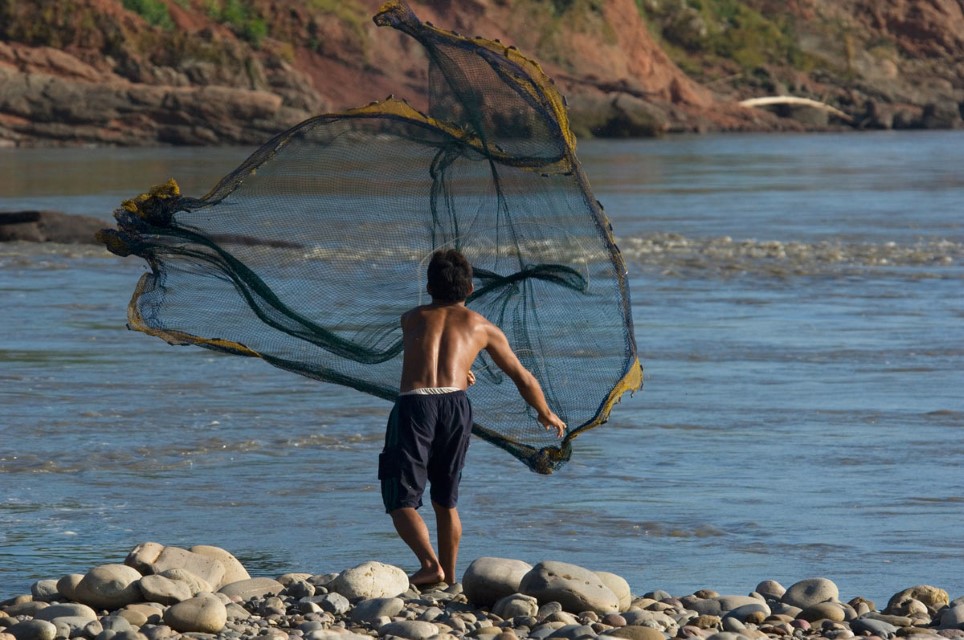The Amazon River system has many headwaters in the Andes. Some of these headwaters rise between 4,000 and 5,000 meters. The upper courses of these headwaters are usually in dry areas where moisture carried by eastern winds is blocked by high mountain ranges. Despite the mountainous terrain, there are few rapids and cataracts in the large Andean rivers. There can be numerous, and often spectacular, waterfalls in the small streams that drain steep slopes. Stream levels fluctuate with local rainfall and there is no prolonged flooding. During the dry season water transparency can be greater than 5 meters in pools, though water depths are usually considerably less than that. Above 3,000 meters, water temperatures are generally less than about 15 °C compared to 24 to 28 °C in the Amazon lowlands.
Above approximately 2,500 meters of elevation, the rainbow trout (Oncorhynchus mykiss), an exotic species introduced in nearly all of the Andes from Colombia to Argentina, dominates the species-poor fish fauna. Many streams have been blocked in the Andes for trout aquaculture and it is possible that the exotic has led to the reduction or extinction of the local fish faunas in many headwater areas. It appears that Andean trout are slowly adapting to live in warmer waters at elevations as low as 1,200 meters in the Peruvian Andes.Trout require high levels of oxygen and cooler water usually has high levels. The main gears used to capture trout are cast nets and line-and-hook. There are few data on these small-scale fisheries and they appear to be mostly for subsistence.
The foothill region of the Andes in the Amazon drainage is a spawning area for at least 20 species of long-distance migratory catfishes and mid-distance migratory characins. Characins such as the curimatã (Prochilodus nigricans), tambaqui (Colossoma macropomum), matrichã (Brycon amazonicus), and pirapitinga (Piaractus brachypomus) migrate upstream from the beginning to the peak of the annual floods to spawn in the foothills, though in general these populations are relatively small compared to those farther downstream. These fish are thought to be populations that reside in the western Amazon no more than approximately 400 km from the Andes.
Andean fisheries are largely uncontrolled. Dynamite is the most common method used in some areas to fish foothill pools, and fish poison (barbasco) has long been used by indigenous groups. Cast nets are also common and can be used most effectively at night in clear waters. Line-and-hook is employed to catch a wide variety of species. Rock weirs are apparently an ancient technique and they are used to corral fish when they are migrating upstream. Rock weir fisheries have been studied in the Upper Pachitea, a tributary of the Ucayali River and they might be an ideal method for studying fish migrations in some Andean rivers.
Large migratory catfish are fished only at a few locations in the Andes. The most important is near the confluence of the Urubamba and Tambo rivers, which together then form the Ucayali River. Drifting gill net fishermen exploit adult populations of ripe dourada (Brachyplatystoma rousseauxii), babão (Brachyplatystoma platynemum), and other catfishes when they are migrating upstream to spawn in the foothills. There are other fishing techniques in the Andes of the Amazon drainage, but they are local in scale and unimportant in commercial fisheries.
-

Los Andes 1
Cast net fishing in the Andes. Photographer: Walter Wust
-

Los Andes 2
Fishing for rainbow trout (Oncorhynchus mykiss) in the Rio Utcubamba, a tributary of the Rio Marañón in the Peruvian Andes. Photographer: Walter Wust
CONTEXT
The Andes
Cataratas
Floodplain or Várzea
River Mouth Bays
River Channel
Estuary & Amazon Coast
Marajó and Inner Delta
